Power Consumption Self Reading App
Due to the COVID-19 pandemic, there was a need to reduce the contact of meter readers that carry out the power consumption reading and inspection for power companies. In this project I was in charge of the UX design of a mobile application embedding an Artificial Intelligence service that would allow recognizing the power consumption of a power meter.
Keywords
Usability Evaluation
Information Architecture
Wireframing
Data Base Modelling
Prototyping
Design Patterns
Functional Testing
UML

Team
Applied Computing Group (ACG)
Role
UX/UI Lead Designer
Location
Brazil – Remote
Timeline
July 2020 – March 2021
Problem: How to improve the usability of a mobile application that will be used as a substitute for reading power consumption in rural regions.
Solution: To evaluate and redesign a mobile app that will use artificial intelligence to measure the power consumption of clients.
Methodology
The redesign process considered five main stages: planning, pilot study, conducting, analysis and redesign. This process was an adaptation of usability evaluation methods. During the planning phase, we defined the goal of the evaluation, participants, metrics, evaluation method and procedures. During the pilot study and conducting phases, we tested the evaluation execution process with a set of users and, given its feasibility, we carry out the overall evaluation process. Then, we analyzed the data and identified improvement opportunities. Finally, based on the proposed suggestions, we created a new version of the user interface, which was then validated with end users and the development team from the Power Company that requested the evaluation of the Power Consumption Self Reading app.

Execution and Results
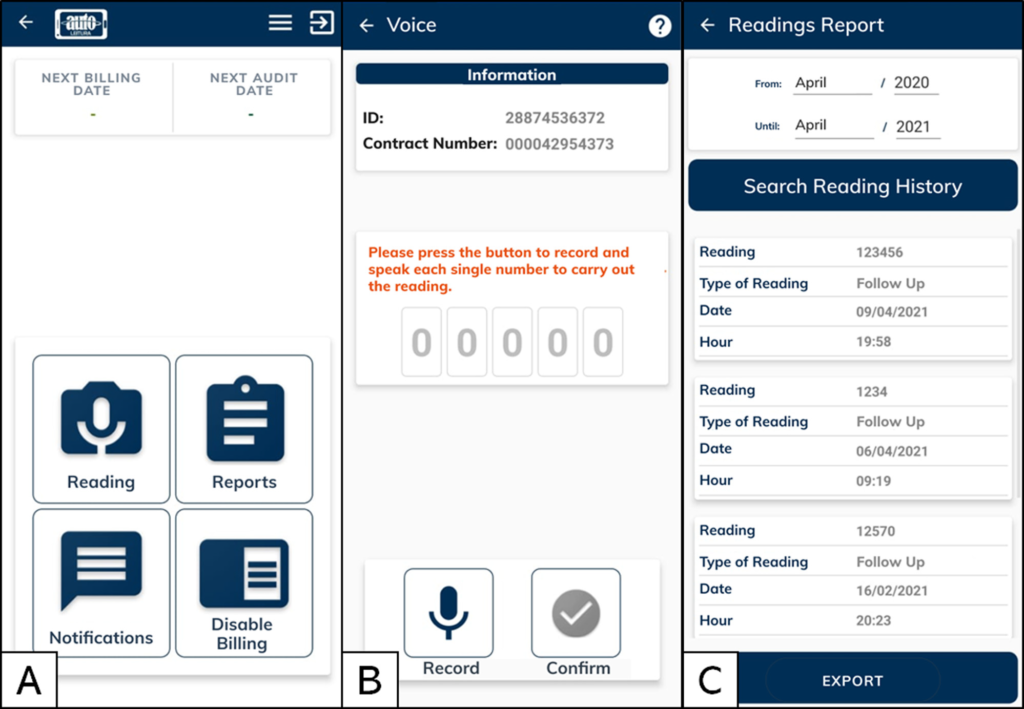
(PLANING)
01A
In Brazil, to register how much energy a customer has consumed, it is necessary to physically travel to the location where the energy consumption meter is installed. Due to the COVID pandemic, the equatorial power company developed an application which recognizes the energy consumption of an energy meter, which is useful in rural areas. This data can then be sent to the company for validation and, based on it, customers can generate reports for further analysis on their power consumption habits.
As the design of the app had not been evaluated, the Equatorial company hired our development group at the ACG to identify usability and UX problems and make suggestions in its design. The initial version of the app had the following features (in Portuguese): (a) user and account management, (b) navigation and data access, (c) image-based, voice-based and text-based power reading, (d) report generation, and (e) client-company communication.
(PLANING)
01B
The goal of the evaluation was to identify usability problems that could prevent users from measuring their power consumption with the app. To do so, we combined usability evaluation methods found in literature to identify requirements and features that positively impacted the quality of use of the app. During the planning stage, we developed a consent form, a characterization form, which are shown in this web page.


(PLANING)
01C
We considered the quality attributes from traditional methods (e.g. Heuristic Evaluation) and recently proposed methods [1]. Based on our review, we proposed a questionnaire and a form so users could fill in and report the identified problems. Users would carry out tasks and after that, they would report their experience and indicate attributes / aspects of the app that impacted such experience.
[1] Weichbroth, P. (2020). Usability of mobile applications: a systematic literature study. Ieee Access, 8, 55563-55577.
(CONDUCTING)
02
We carried out a pilot study, where some users applied the procedures and artifacts to report their experiences. After validating the artifacts and tunning them, when necessary, we carried out the study with volunteers who were fit the end user’s profile. Participants who paid power bills and knew how the power company agents measured the power consumption were considered for the usability study. These participants installed the initial version of the app and tried using it considering the set of defined tasks. Then, they filled in the artifacts to report their experiences. Some of the identified problems are listed as follows.

(ANALYSIS)
03
The main goal of the quantitative analysis was to verify to what extent the identified problems were a common opinion among users. We analyzed if a problem was indicated by more than one user considering similar descriptions of the same problem, its location and its improvement suggestions. We also categorized the problems according to their correction priority (low, medium, high). The analysis allowed us to identify several usability and functional problems across the app. Also, we generated a report in which we highlighted each problem in the UI, its degree of importance, the impact for achieving user goals, and improvement suggestions. At all, from 99 usage scenarios, 15 were considered faulty, yielding usability improvement opportunities.

(REDESIGN)
04A
We proposed the information architecture for organizing, structuring, and labeling content in an effective way. Our goal was to help users find information and complete tasks.
The information architecture presented in this page displays the pages and interactions of the Power Consumption Self Reading app from the point of view of a Client.
(REDESIGN)
04B1
We developed prototypes for the Power Consumption Self Reading app that showed stakeholders and potential users the improvement suggestions based on the feeedback we obtained during the evaluations. For instance, we redesigned the home screen, so users would have access to all functionalities without entering a separate menu. Additionally, in this screen the customer can view his/her account information and relevant information regarding measurement dates. Finally, regarding the interaction with the reading through camera option, we included further minimized options, such as adding small buttons and messages through the interaction process.
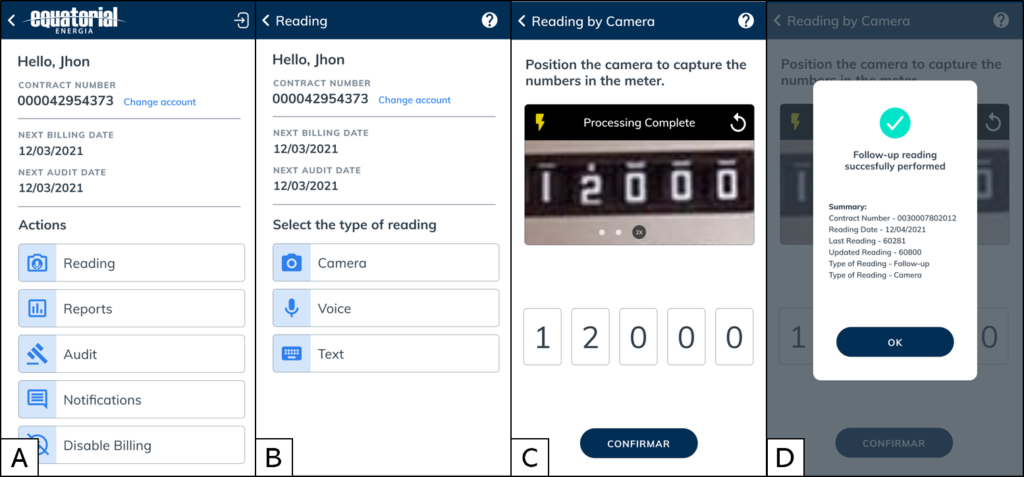
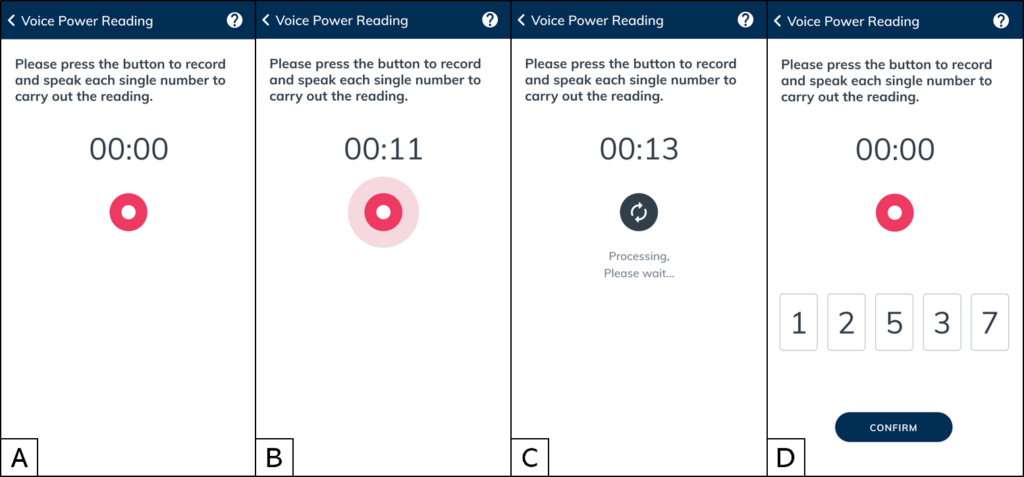
(REDESIGN)
04B2
We added visual information to represent the changes in the processing of a task. For instance, a new circle appears to indicate that the record has started. Additionally, message colors were changed and in between processing messages were added.
(REDESIGN)
04B3
We made the reports screens similar, and we added information in the screen depending on the type of response of the system.
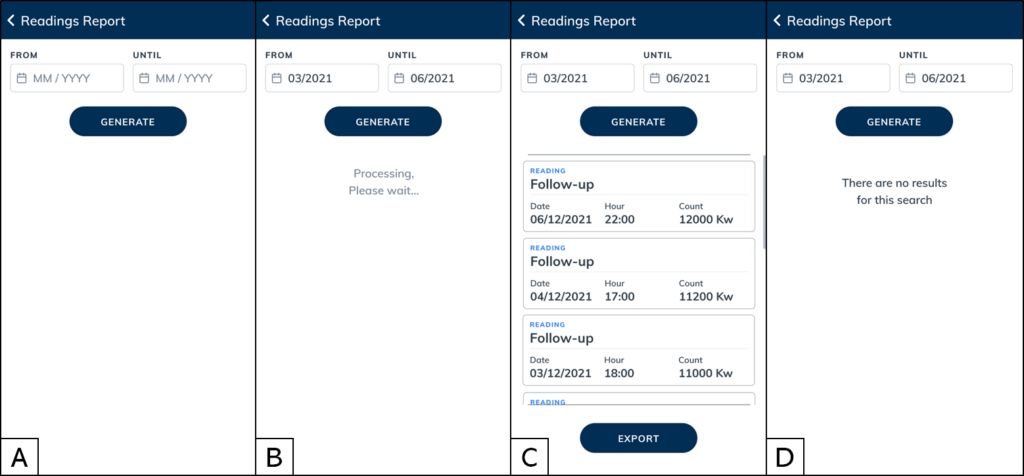
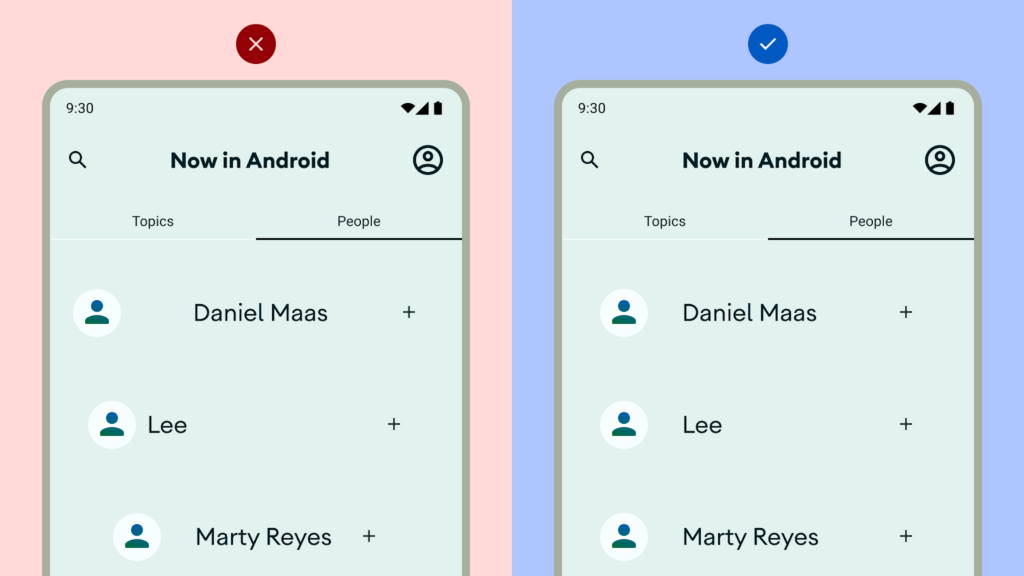
(REDESIGN)
04C
Sometimes it is good to stop and reflect on the many factors that affect usable design. However, there are projects in which ready-to-use solutions are necessary to reduce time and effort to make improvements in the UI. Thus, in this project, we also considered UI design patterns available in design repositories, such as: [2], [3] and [4].
[2] Neil, T. (2014). Mobile design pattern gallery: UI patterns for smartphone apps. ” O’Reilly Media, Inc.”.
[3] Android Mobile Design Patterns.
[4] iOS Mobile Design Patterns.
- The End -
As a result of the evaluation process a new interface was designed to correct the identified problems. This new screen was validated by the managers of the Equatorial power company, indicating satisfaction and that with the changes, users (including themselves) could use the system more easily without going against any company design or process policy.
The identification of usability problems often came with a suggestion from the point of view of the participants, mainly when noticing that relevant information was missing, or that there was no layout, image or font standardization. The discussion of the identified problems with the Equatorial power company allowed for the refinement of the suggestions and prototypes. One of the main problems was that although some changes were accepted by the managers, they could not be approved considering that they could go against the company’s policies. For instance, color had to maintain the same, as well as images and interaction processes, to maintain a standard with other mobile applications that the company provided its clients. This, however, is helping the company take notes on what changes could be necessary not only for this project.